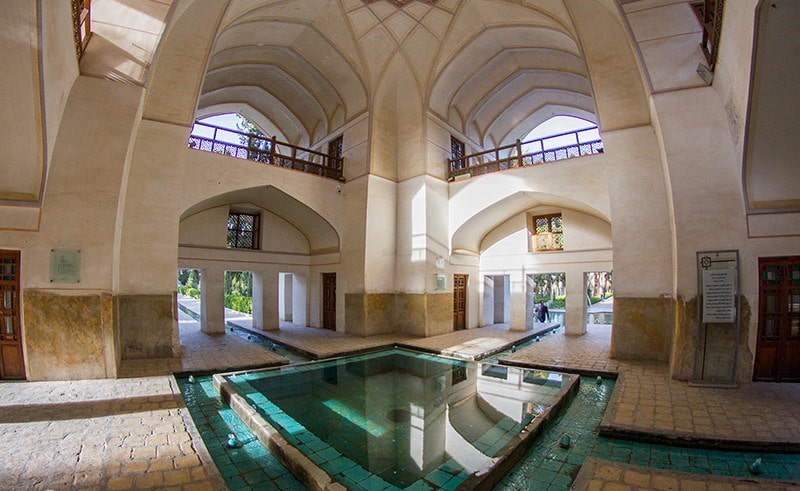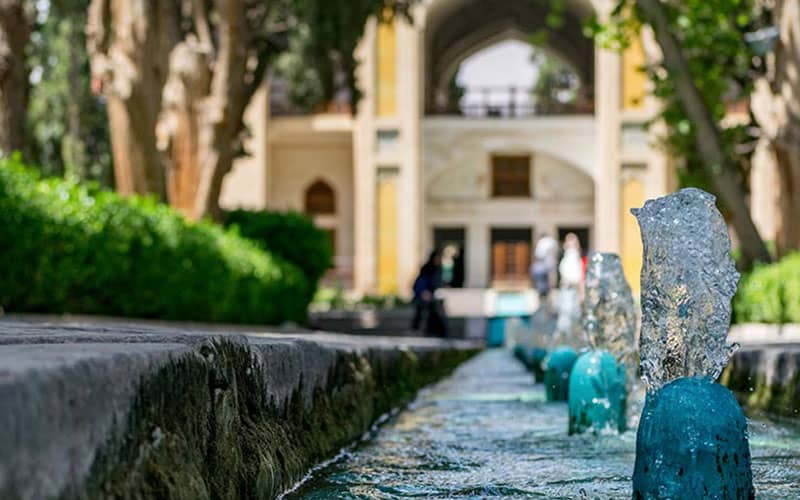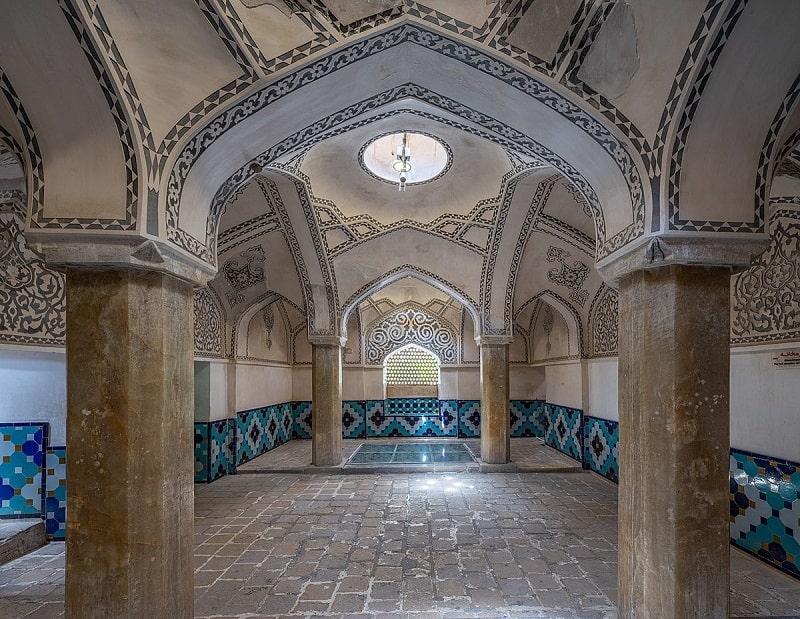Introduction to Fin Garden
Persian gardens and their worldwide fame have made them commercial and visited by art and architecture lovers every year. Gardens either in the heart of the desert or among the greenery of forests with outstanding architecture contain water as a particular element. Fin Garden is a wonderful green area with tall walls, departed from the city and its crowds. The garden is an excellent example of Persian Garden architecture that still attracts all eyes after hundreds of years. Upon arrival, the unique features of the Fin garden as soaring trees, short and long fountains as well as the sound of passing water will enchant you.
History of Fin Garden
In the past, the garden’s name was Shah Garden due to its large area, but later it became known as Fin since it was located in the Fin region of Kashan. The garden is an artistic masterpiece that we cannot determine exactly how old it is. Some believe that it emerged during the Sassanid dynasty, however in some historical sources it is dated to the time of the Saffari dynasty, and another group of scholars introduces the Buyids or Ilkhanate dynasty as the garden’s founder. With all these hypotheses, the date of construction of the current Fin Garden refers to the reign of Shah Abbas Safavid. During the Shah Tahmasp II Safavid rule, an enormous earthquake led to the garden’s destruction. Remains of the mentioned earthquake are still left today, known as the Old Garden is a few hundred meters from the Fin Garden (New Garden). During the reign of Shah Abbas I, who was one of the most prestigious Safavid kings, orders were issued for the city of Kashan development, which was at the same time as the garden’s construction.
From the end of the Safavid period to the Zandieh era, due to the invasion of Afghans and Nader Shah wars, no attention was paid to the garden, but in the Karim Khan Zand reign, at the same time with several consecutive earthquakes, the Fin complex was restored and Karim Khani’s private building was added to the complex. After Karim Khan, Bagh-e Fin or Fin Garden came out of the spotlight again and returned to its glory during the reign of Fath Ali Shah (the second Qajar king). Fin Garden has witnessed significant events and incidents. Such as the Safavid kings’ celebration, the Kashan ruler’s murder, the assassination of Amir Kabir – the Prime Minister of Persia, the death of Shah Safi, and the immediate coronation of his son in such a complex.

The architecture of Fin Garden
Iran’s Cultural Heritage Organization considers Fin garden designer Ghias al-Din Jamshid Kashani, however, academic sources introduce the garden designer as Sheikh Bahaei.
Symmetry
The architecture of Kashan Fin Garden is completely following the principles of gardening in Persia. One of the particular features considered in the garden’s design is maintaining symmetry; however, with the intervention of the kings, the balance gradually diminished. The highest degree of asymmetry in the garden occurred during the Safavid period.
Water in Fin Garden
What is most noticeable in the garden is the presence of water and tree elements that have created stunning architecture along with historical monuments. In the design of Fin Garden, water is an essential element, and has been used in different ways in this garden, evoking a distinct concept. Another phenomenon of Kashan Fin Garden is its water supply system, which presents the genius of ancient Persian architects; The flowing water, supplied from Soleymani spring, has a constant volume throughout the year.

Trees
The presence of aqueducts has provided the water needed for the garden, trees, and vegetation to continue to live you can see tall and towering trees there. The most valuable plants in Fin Garden include 579 cypress trees and 11 sycamore trees. Perhaps it can be said that the choice of the cypress tree is since, in Persian literature, the cypress is a symbol of human beauty.
Ponds
The spectacular garden includes a central courtyard surrounded by battlement towers. The Joosh pond and the twelve-fountain pond are the two picturesque ones in the complex, where people ask for their wishes by dropping coins into them. They believe that by doing so, the wishes may become true.
Joosh Pond
The charm of the Joosh pond is due to its flooring, which contains superb paintings such as Toranj carpets and the Kashan altar. Additionally, some gold has been used on the pond’s tiles which, unfortunately, were present until the beginning of Reza Shah’s period and were later stolen by looters. There are 160 holes in the Joosh pond, each of which was a carpet flower.
Twelve-Fountain Pond
This pond was added during the reign of Mohammad Shah Qajar, at the same time as the royal residence room in the garden. The fountains inside the pond depict the Persian structure and architectural masterpieces in the distant past.
The Sar-Dar Mansion
Entering the garden, you will see a tall, brick, two-story mansion called the Sar-Dar (Entrance Porch), which used to be a waiting place for those who came to the garden.
Safavid Kushk
The mansion of the Safavid Kushk (A mansion in the middle of the garden in Persian Architecture), also known as Sufeh Abbasi, was built in the centre of the garden, in front of the gate of Shah Abbas required and the efforts of Agha Khezr Nahavandi, the ruler of Kashan, in 1607. In the past, the mansion contains four floors; its upper two floors were in the shape of a pavilion, but after an earthquake in 1777, it was severely damaged, and only two floors with a height of 14 meters were rebuilt during the reconstruction.
The mansion was a place for celebrations and ceremonies, with women upstairs and men downstairs during the festivities. In the interior, the delicate art of the Safavid era, and paintings done by Reza Mosour Kashi or the famous Reza Abbasi will dazzle your eyes. The artist’s work was so fascinating that Shah Abbas took him to Isfahan to do the incredible paintings of Ali Qapu and Chehelston after observing his works.
Shahneshin (The Royal Room)
The Shahneshin was built around 1839 on Mohammad Shah Qajar’s demand. Around the building, there are rooms for the crew called Goushvareh, due to the respect that they had for the king, ceremonies were performed through the side doors, and they never entered this room through the main entrance. Stained glass is one of the aesthetic highlights of such a room that contributes to the light that shines inside becoming a thousand colours.
Teahouse
After Shahneshin, next to the Qajar Kushk or pavilion, there is a building called Chaykhaneh, which in the past was called Cheshmeh Zananeh. All the incoming water is divided into the garden in Teahouse, one-third of the mainspring’s water flows into the building; having been divided into three branches, it continues its way into the garden.
Qajar Kushk
The Qajar pavilion, known as Fath Ali Shahi ostrich or Fath Ali Shahi Sufeh, was built by the order of Fath Ali Shah in 1810 in the south of the garden. The building includes the spring house, the four arches (Chartaqi) with the Joosh pond, Shehneshin, and a large and covered plateau with four porches with marble floors. There were paintings on the ceiling that was the work of Sani Al-Mulk Ghaffari, uncle of Kamal Al-Mulk, a skilled Persian painter, but after the death of Amir Kabir, due to lack of protection, these artworks were destroyed because of moisture or human factors until the paintings were found in the album of a French tourist, and Master Motifi Far reconstructed them.
Fin Bath
Interestingly to know, the name of neither of the two baths in the garden is Fin, but they are known only because of their location in Fin Garden.
The small bath belongs to the Safavid period, having seven old tiles in the Khazineh which are about 500 years old. The bath was built for servants and was famous because of the assassination of Amir Kabir, the honourable Prime Minister of Persia. The royal bath or large bath was built during the Qajar period by the order of Fath Ali Shah and was for the Qajar kings. That is why it has outstanding architecture; The marble columns and painted ceiling nail every viewer in place.

Kashan National Museum in Fin Garden
Kashan National Museum is on the west side of Bagh-e Fin; The museum was built in 1967 by Seyyed Mohammad Taghi Mostafavi, the director of archaeology, on the ruins of Nizam Al-Dowleh. It includes three sections: anthropology, archaeology, and handicrafts, and more than 400 pieces of works, such as pottery belonging to pre-Islamic and post-Islamic ages, including ceramic and bronze objects, calligraphy, and clothing, are on display in such a museum that covers from the seventh millennium BC to the contemporary period. The objects of the archaeological section have also been obtained from the excavations carried out in Silk, Choghaznabil and Hasanlu, hills.

